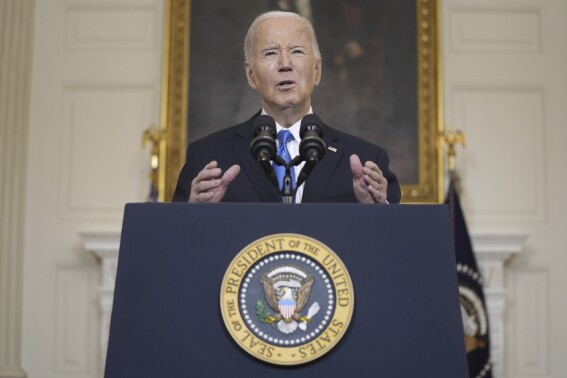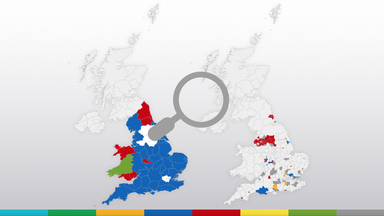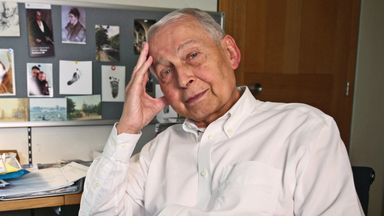WASHINGTON (AP) — Puerto Rico will hold a Democratic presidential primary on Sunday, which will be the only opportunity most registered voters on the island will have to officially weigh in on the race for the White House.
Like other U.S. territories, voters in Puerto Rico can’t cast ballots in the general election but may participate in presidential primaries and send delegates to both the Democratic and Republican national conventions this summer.
President Joe Biden has already won enough delegates to secure the Democratic nomination and faces minimal opposition on the ballot Sunday. The Democratic primary was originally scheduled for March 17, but party officials moved the event and implemented cost-saving measures like reducing the number of polling places once it became clear Biden had locked up the nomination. The party estimates the scaled-back primary will cost less than $60,000, down from the approximately $1 million the State Elections Commission had originally budgeted. Puerto Rico Republicans scrapped their traditional primary and instead awarded their 23 delegates to former President Donald Trump on Sunday in a caucus-style vote at which approximately 77% of 1,340 eligible party officials participated. Trump was the only candidate on the ballot.
Although residents of Puerto Rico can’t vote for president in November, they could potentially still influence Electoral College calculations. In the 2020 general election, both the Biden and Trump campaigns had outreach efforts in Puerto Rico with the hopes that voters there would in turn influence their friends and relatives on the U.S. mainland.
Last month, Vice President Kamala Harris visited Puerto Rico to tout the Biden administration’s record on disaster relief and to attend a fundraiser. The trip came days after Biden launched a new effort to target Latino voters.
According to a 2023 Pew Research Center analysis of Census data, about 5.8 million Puerto Ricans live in the 50 states and the District of Columbia. About 21% of stateside Puerto Ricans reside in Florida, followed by 17% in New York and 8% each in New Jersey and Pennsylvania.
Trump carried Florida by a margin of 3 percentage points in 2020 and 1 percentage point in 2016. The races were even closer in Pennsylvania, which Biden won by 1 percentage point in 2020 and Trump won by less than a percentage point in 2016.
Biden won the 2020 Puerto Rico primary, which was postponed twice to the very end of the Democratic primary calendar in mid-July because of the coronavirus pandemic. He received 62% of the vote over Bernie Sanders, who received 15% of the vote, and Michael Bloomberg, who received 14%. Hillary Clinton had a similar showing in 2016 with 61% of the vote to 38% for Sanders. Clinton also won Puerto Rico in 2008, when the territory was one of the last places to vote in the marathon nomination fight between the former U.S. secretary of state and then-Sen. Barack Obama.
Here’s a look at what to expect on Sunday:
PRIMARY DAY
The Puerto Rico Democratic presidential primary will be held Sunday. Polls are open from 9 a.m. to 3 p.m. ET.
WHAT’S ON THE BALLOT
The Associated Press will provide coverage for the Democratic presidential primary. It is the only contest on the ballot. Appearing on the ballot are Biden, self-help author Marianne Williamson and U.S. Rep. Dean Phillips, who suspended his campaign after Super Tuesday and endorsed Biden.
WHO GETS TO VOTE
Puerto Rico does not register voters by party, so all voters who registered by March 29 are eligible to participate in the primary, provided they are willing to sign a document at the polls declaring themselves as Democrats. Those unwilling to sign the document will not be permitted to vote.
DELEGATE ALLOCATION RULES
Puerto Rico’s 55 pledged Democratic delegates are allocated according to the national party’s standard rules. Twelve at-large delegates are allocated in proportion to the statewide vote, as are seven PLEO delegates, or “party leaders and elected officials.” The state’s eight state Senate districts have at stake a combined 36 delegates, which are allocated in proportion to the vote results in each district. Candidates must receive at least 15% of the statewide vote to qualify for any statewide delegates, and 15% of the vote in a congressional district to qualify for delegates in that district.
DECISION NOTES
Biden is the overwhelming favorite in the primary. The first indications that he is winning statewide on a level consistent with the overwhelming margins seen in most other contests held this year may be sufficient to determine the statewide winner.
The AP does not make projections and will declare a winner only when it’s determined there is no scenario that would allow the trailing candidates to close the gap. If a race has not been called, the AP will continue to cover any newsworthy developments, such as candidate concessions or declarations of victory. In doing so, the AP will make clear that it has not yet declared a winner and explain why.
WHAT DO TURNOUT AND ADVANCE VOTE LOOK LIKE
Turnout in past Democratic Puerto Rico primaries has varied greatly depending on the competitiveness of the race and other factors.
Only 6,302 votes were cast in the 2020 primary. In 2016, Democrats in Puerto Rico cast 89,188 votes in the June 5 contest, held on the second-to-last day of the primary calendar. Nearly 387,000 votes were cast in the 2008 primary between Obama and Clinton.
Voters had until March 14 to request a mail-in absentee ballot. According to party officials, a limited amount of early voting was available to those who qualified and requested it by March 9. Early voting will also be offered to inmates at correctional facilities on Friday.
HOW LONG WILL VOTE-COUNTING TAKE?
Polls close at 3 p.m. ET. Party officials expect to have final results by about 5 p.m. ET.
ARE WE THERE YET?
As of Sunday, there will be 113 days until the Democratic National Convention in Chicago and 191 until the November general election.
___
Follow the AP’s coverage of the 2024 election at https://apnews.com/hub/election-2024.
Yoon is an elections and democracy reporter for The Associated Press, with a focus on analyzing vote and demographic data and explaining the intricacies of the electoral process. He is now covering his seventh presidential campaign cycle.Disclaimer: The copyright of this article belongs to the original author. Reposting this article is solely for the purpose of information dissemination and does not constitute any investment advice. If there is any infringement, please contact us immediately. We will make corrections or deletions as necessary. Thank you.



